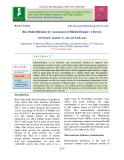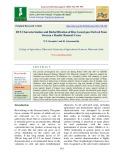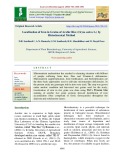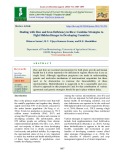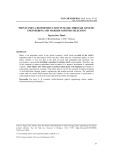
Rice biofortification
-
Biofortification is an effective and economical method to improve the micronutrient content of crops, particularly staples that sustain human populations in developing countries. Rice (Oryza sativa), one of the most important food crops in the world, feeds more than half of the world‟s population and issued as a staple food in many parts of Asia.
 10p
10p  cothumenhmong9
cothumenhmong9
 18-01-2021
18-01-2021
 14
14
 2
2
 Download
Download
-
The present investigation was carried out during Kharif 2016 and 2017 at AICRIP, Agricultural Research Station, Mugad, UAS, Dharwad. Among 37 characters studied, the variation was observed in 30 characters viz.
 8p
8p  cothumenhmong5
cothumenhmong5
 17-05-2020
17-05-2020
 15
15
 2
2
 Download
Download
-
Micronutrient malnutrition has reached to alarming situation with billions of people suffering from Iron, Zinc and Vitamin-A deficiencies. Micronutrient supplementation, food fortification, and biofortification are the three basic approaches used to alleviate micronutrient deficiencies. In the present study ten genotypes rich in iron were used.
 4p
4p  cothumenhmong5
cothumenhmong5
 17-05-2020
17-05-2020
 14
14
 1
1
 Download
Download
-
Zinc and Iron are essential micronutrient for both plant growth and human health but it is often reported to be deficient in regions where rice is use as staple food. Although significant progresses are made in understanding genetic and molecular mechanism of micronutrient acquisition but these need to be characterize to increase the bioavailability of these micronutrients. Biofortification is suggested to be a sustainable and costeffective approach in this perspective and for that combination of various agronomic and genetic strategies should be put in place without delay.
 10p
10p  quenchua4
quenchua4
 06-04-2020
06-04-2020
 17
17
 1
1
 Download
Download
-
Maize is an important cereal in the global economy, which feeds one-third of the world’s population and is the third largest food crop after wheat and rice. Nutritional quality of most maize varieties is very low due to the lack of lysine and tryptophan and extremely low provitamin A carotenoids including α-carotene, β-carotene, and β-cryptoxanthin. Therefore, one of the solutions to improve nutritional value in maize is to improve provitamin A carotenoids contents. Many efforts have been made to produce maize plants with enhanced provitamin A carotenoids, especially, β -carotene.
 17p
17p  12120609
12120609
 23-03-2020
23-03-2020
 14
14
 0
0
 Download
Download
CHỦ ĐỀ BẠN MUỐN TÌM









